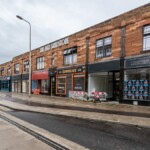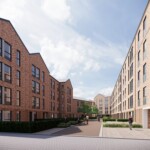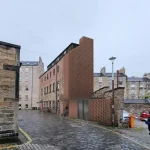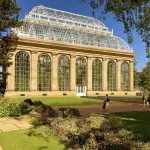Jeffrey Street, Allan Murray Architects, Scotland, Building Images, Project Photos
Jeffrey Street, Old Town
Scottish Capital Architecture – New Property in Scotland, UK
post updated 28 July 2021
Allan Murray Architects – Building PR 2001
“Flat Iron” – Jeffrey Street, Edinburgh, Scotland
Jeffrey Street, Old Town, Edinburgh
Award-winning Allan Murray Architects, on behalf of the EDI Group, have prepared exciting proposals for the redevelopment of the Jeffrey Street arches to extend and enhance the nascent arts quarter of the Waverley Valley beyond the visual barrier that is North Bridge. The refurbished sequence of workshops and offices within the existing empty vaulted spaces will link to a new building which is proposed for the currently vacant Cranston Street site.
Historical research suggests that as a part of the ‘City Improvement Act of 1867′, Jeffrey Street was intended to be fully constructed on both sides in a similar manner to that of Cockburn Street but was never fully realised. The proposal seek to redress the visually weak termination of Jeffrey Street in an appropriate and contemporary way with a quality landmark building.
The proposal will also revitalise and enliven the underused route of East Market Street with a series of workshops and offices together with restaurants and bars on the lower floors of the new building. Allan Murray Architects’ design includes two new public staircases which link East Market Street with Jeffrey Street to further increase the permeability of the Old Town.
At the Jeffrey Street level the proposals include shops culminating in a cafe bar in the ‘prow’ which will draw more pedestrian activity along Jeffrey Street. The upper floors, are high quality offices (also entered from Jeffrey Street), as opposed to residential in a bid to bring people back to work in the City centre, creating more day time custom for local shops and restaurants.
The overall aim of the project is to provide a high quality environment for local residents, workers and visitors. It will create new links between the Old Town, Waverley Valley and other key City developments. The project is intended to be complete by the end of 2002 at a cost of £3.5 million.
Client: EDI Group Ltd
Architects: Allan Murray Architects Ltd, Edinburgh
0131 313 1999
Project Architect: Steven McGillivray
Agent: Lang LaSalle
Project Manager & Quantity Surveyor: Robb Clark
Structural, M&E Engineer: Johnston & Partners
Fire Consultant: Fire Consultants Ltd
Lighting Architects: Spiers & Associates
Allan Murray Architects
Jeffrey Street: Building PR 24 April 2001
Jurys Inn hotel Jeffrey Street building
Allan Murray Architects: Letter re Jeffrey St to Alan Henderson
Cockburn Association Information Online Release 22.05.01
Memo of meeting between Mr Paterson and Mr Walker,
manager of Railway Company Saturday 7 August 1875
III) Instead of the Railway Company forming the street they are bound under the agreement to construct, they shall acquire the ground between the south boundary of the property coloured red, the North side of Jeffrey Street (being from Leith Wynd westward) and form on such ground a substantial street in every respect the same as the one under agreement…
V) the Company to modify the provision of article VIII of the Agreement 1872 as to the height of the building erected on their property to the extent that such buildings shall not exceed in height the finished level of the carriageway of Jeffrey Street.
City Improvement Trust Minutes 21 September 1875
Submitted report from Works Committee recommending with the view of improving the amenity of Jeffrey Street that a portion of the north side thereof be not built on an the same be ceded to the North British Railway Company.
Letter by William Millar Esq., 43 Hanover Street, Edinburgh, 17 December 1875.
My Lord Provost,
I am sure the community – or that part of it which knows how desirable it is to preserve and increase the amenity of our city – must be greatly indebted to your lordship for the proposal of not building on the north side of Jeffrey Street.
How deeply would it not be afterwards deplored were the mistake committed of building it up, when the opportunity occurs of keeping it open.
Perhaps your lordship may not be aware that about the year 1827 the Lord Provost and Town Council of that day had resolved to build n the south side of Princes Street and it was only because of the energetic action of Lord Cockburn and their citizens that the atrocious project was with much difficulty stopped.
In all such cases there will be found persons who take the view that the wrong question is paramount.
I humbly think however, that the 1 question with the Improvement Trustees is necessarily the Improvement of the City – the matter of cost is subordinate.
I do now know the details sufficiently to understand how the decision of Tuesday last in regards to Ireland’s Woodyard affects the question but if the Improvement Trustees have to give the Town or anybody else say £5000 to prevent building where building should not be, surely that would be an application of the Improvement funds in accordance with the spirit of the Act, which if need be, a clause of indemnity for, might be obtained in the next Act of Parliament.
Memorial from Royal Scottish Academy of Painting, Sculpture and Architecture unto the Right Honourable the Lord Provost and Councillors of the City of Edinburgh.
At a special General Meeting of the Royal Scottish Academy, held of the 27th to discuss aesthetic relations of the respective proposals for the completion of Jeffrey Street now under consideration by the Improvement Trust, it was resolved…that the Academy, representing as it does, the artistic opinion not of Edinburgh only but of the country at large, would fail in its duty were it to refrain from laying before the Trust the respectful expression of its convictions on a subject so materially affecting the amenity of the City.
The Academy rejoices to know that in the municipal body there is a clear recognition of the principle that is one of the more important duties of that body to conserve and where possible, to augment the natural beauty of the City.
The Academy rejoices also to know that in the Improvement Trust a strong feeling exists in favour of the abandonment of the proposal to build on the north side of Jeffrey Street a row of tall houses with their backs towards the New Town.
And indeed, the Academy believes it impossible that any such body of intelligent men should doubt that the execution of the plan as originally proposed must prove to the last degree injurious to the appearance of that part of the City from several important points: more especially the great approach by Railway from the south, Waterloo Place and the trunk thoroughfare of the North Bridge.
It therefore feels it would be an insult to the judgement of the Trustees to support this view by any formal arguments.
On the point of taste, the Academy believes that no difference of opinion exists in the Trust, also that the Trustees are fully alive to the great material advantage – to put it on no higher grounds – accruing to the community of Edinburgh from the preservation of the amenity and salubrity of the City – on which, in so many different ways, its prosperity depends…It is led to understand however, that the threatened public calamity referred to may be averted by the sacrifice of a sum of money altogether insignificant when compared with the large present and prospective interests at stake and with the large sums already expended in the amelioration of the condition of the old town and in augmenting the attractions of the city as a whole.
And it would beg respectfully to express its earnest hope that if this be the case, those on whom the onus of decision rests will not be deterred by a misplaced economy from making the slight pecuniary sacrifice required to secure the carrying out of the agreement which contemplates leaving the north side of Jeffrey Street unbuilt on.
All are agreed that this agreement would add enormously to the dignity and beauty of that much exposed portion of the old town; and at the same time, preserve for the future what yet remains of the magnificent prospect towards the Firth as seen from North Bridge and from Jeffrey Street itself.
In name and on behalf of Royal Scottish Academy, Noel Paton Chairman, J Dick Peddie, Secretary.
Extract from minute of meeting of the Council of the Cockburn Association for the Improvement of Edinburgh and its neighbourhood, held on 13 December 1875.
It was reported to the Council that there had been a proposal made to the City Improvement Trust to build a line of houses on the north side of the proposed street called or to be called Jeffrey Street.
That such line of houses would materially interfere not merely with the amenity of Jeffrey Street itself but with the view of the whole valley looking from the North Bridge and of the Old Town looking from the Railway: and the Council are informed that the whole benefit to be derived from such a line of houses might be estimated at £58 a year.
The Council are strongly and unanimously of the opinion that it would be a very great misfortunate if the Improvement Trust were to adopt a proposal which so far from being an improvement would be highly injurious to the amenity of that part of the City.
The line of Jeffrey Street as proposed and the architectural character of the buildings as proposed to be erected are very appropriate to the site and harmonise with the character of the buildings in Cockburn Street and the general character of the Old Town buildings and it would in the opinion of the council be a very great pity if the appearance of the street and the view of the new church were disfigured and hidden by the proposed erection on the north side of the street.
The Council desired a copy of this minute to be sent to the Lord Provost to be laid before the Trustees and appointed Sir R Christison, Mr Blyth, Mr Paton, Mr Haldan to present the views of the Council at the next meeting of the Improvement Trustees…They are well aware they have no right to interfere with the Trust in their deliberation and have perfect confidence the Trust will decide for the best interests of the City. p461.
Works Committee Book 23 February 1876
The meeting took into consideration Report by Mr Watherston and Mr Beattie and Report thereon by Mr Robert Paterson, where the tenor of said Report follows:
Mr Watherston and Mr Beattie’s Report.
We have your letter of the 10 with printed report by Works Committee of the Edinburgh Improvement Trust and relative plans, asking our opinion in regard to the same as to the value of the additional ground proposed to be acquired by the North British Railway Company.
We are of the opinion that the financial effect of abandoning the north side of Jeffrey Street to the extent of 438 feet will be as detailed below, and that the North British Railway Company should pay at the rate of £2.10/ per square yard for the 2141 yards of grounds they propose to acquire.
Loss on Jeffrey Street with North side unbuilt.
Value of feuing frontage to be destroyed on north side of Jeffrey Street, 438 feet lineal at £1 = £438 which at 22½ years of purchase is equal to £9855.
Value of arches below Jeffrey Street, fitted up as cellarage in connection with the old tenements – letting value £220.
Deduct cost of fitting up to say £2000 at 6% – £100.
This surplus rental of £100 to be taken at 16 years purchase is equal to 1600.
Total – £11,455.
Gain on Jeffrey Street with North side unbuilt.
Increase on value of 350 feet of south side of Jeffrey Street to the extent of 5/per feet = £87.10/ at 22½ years purchase, equal to £1969.
Value of arches below Jeffrey Street, fitted up as warerooms and offices, letting value £370.
Deduct cost of fitting up say £3000 at 6 per cent.
This surplus rental of £190 to be taken at 16 years purchase is equal to 3040.
Value of 2141 superficial yards of ground to be acquired by the North British Railway Company at £2.10/ per superficial yard – £5352.
Total – £10361.
The difference between the above sums viz. £1094 is the loss if north side of Jeffrey Street is left unbuilt.
Signed Wm. Watherston, Wm. Beattie.
Mr Robert Paterson’s Report.
Report under remit by the Works Committee of the City of Edinburgh Improvement Trust of date 3 February 1876 as to the proposed transference to the North British Railway Company of the north side of Jeffrey Street.
In obedience to this remit, I beg to offer the following explanations with the view of shewing the true position of this question viz.
The proposal to abandon building on the site forming the north side of Jeffrey Street, originated with the Improvement Trustees, the chief arguments used in support of the proposal being a strongly expressed opinion that any buildings on that side would be a serious injury to the amenity of the City and it was further stated that by moving the intended low level road further southward, an improved gradient would be obtained.
In furtherance of the resolution of the Improvement Trust not to build on the site, I was directed to open negotiations with the Railway Company, with a view to its being sold to them, as an addition to the areas to be acquired by them under the Agreement of 1872.
The Agreement of 1872 provided that certain areas of Physic Gardens should be acquired by the Improvement Trustees and transferred to the Railway Company at the prices paid by the former and the cost of these properties had previously to the negotiations before referred to been fixed at £10337.
At the threshold of my negotiations with the Railway Company, in regard to the site of the north side of Jeffrey Street, I had to insist upon the Railway Company giving up a right they had unfortunately acquired by the Agreement of 1872 to erect on theirground, situated immediately to the north of Jeffrey Street, buildings of the height of 50feet to the eaves, as it would manifestly have been folly to sacrifice the north side of Jeffrey Street as a building site, for the sake of amenity, and to allow the Railway Company to continue in possession of the power to erect corresponding buildings on their ground which would equally have destroyed the amenity.
The Railway Company put great value on the possession of this right, and it was in virtue of their ceding it that they at first offered to purchase the Jeffrey Street site at £800 instead of £2142, the sum I proposed they should pay as being the cost of the ground to the Improvement Trust.
After much negotiation however, the Railway Company agreed to restrict their rights so that no buildings on their ground should exceed in height the finished level of carriageway of Jeffrey Street, and to pay the sum of £2142 for the ground.
It humbly appears to me that in the face of resolution that the north side of Jeffrey Street should not be built upon, it is a mistake to expect the Railway Company or any one else to pay for it as a building site.
In view of all the circumstances, but especially the conservation of the amenity by avoiding building on the site referred to, the concession of the Railway Company as to the height of their buildings and the Improvement of the gradient of the low level street – upon which there will be heavy traffic – the Railway Company, in my opinion, act fairly to the Improvement Trust in offering the price which the ground the ground in question cost the Trust and they are thereby following out the principle of the Agreement of 1872.
It has been assumed and stated that the sum of £2142 was my valuation of the site in question and valuations of the property as a building site have been obtained and compared with it as such.
I beg therefore respectfully to thank the Committee for affording me the opportunity of demonstrating, by an unvarnished statement the history and facts of the case that this assumption and comparison are equally fallacious.
Respectfully submitted by (signed) Ro Paterson, Edinburgh, 22 February 1876.
After consideration, the meeting agreed that Mr Paterson’s Report be submitted to Mr Watherston and Mr Beattie and that they be requested to state whether in view of the information therein contained, they adhere to their valuation and on receiving their answer, the Clerk was instructed to print the minutes of the Committee under the remit of the last meeting of the Trust, including the valuations and reports by Messrs Watherston and Beattie and Mr Paterson for the information of the Trust.
Signed James Falshaw, Lord Provost.
Works Committee Book 24 November 1876
There was submitted adjusted Memorandum of Agreement betwixt the Trust and the Railway Company…the Company have agreed to the restriction as to chimneys to the extent of 30 feet from the low level street and the like distance from Market Street west of the North Bridge….the meeting unanimously approved therefore.
The tenor of the adjusted Memorandum is as follows:
Memorandum of proposed agreement between the City Improvement Trustees and the North British Railway Company
That the value of the property at Physic Gardens (exclusive of Ireland’s Woodyard Ironside Court consisting of 2348 yards) north of the south boundary line coloured red on the plan be stated at £10377 exclusive of the expense of purchase and incidental thereto which it is agreed shall be fixed at 7½ per cent on the said sum.
But as is the said sum the price of a small property belonging to the Railway Company and valued at £500 is included, no payment to be made thereof to the Railway Company.
The interest to be paid by the Railway Company up to Martinmas 1876 to be £550.
That of the property known as Ireland’s Woodyard, Ironside Court extending to 2348 square yards, 2158 square yards shall be held by the Railway Company at the price of £6392 and 190 square yards by the Improvement Trustees at the price of £608.
Instead of the Railway Company forming the street they are bound under the Agreement to construct, they shall acquire the ground between the south boundary of the property coloured red and the north side of Jeffrey Street (being Leith Wynd westward) and form on such ground a substituted street in every respect the same as the one under the Agreement, the price to be paid for the ground to be £3000 inclusive of all charges.
The substituted roadway however to be subject to the approval of the Town Council and Road Trustees.
Interest to run from Martinmas 1876 and the Company to take all burden in consequence of deviation from the roadway sanctioned by the Act of 1872.
The Improvement Trustees to sell to the Railway Company the property on the West side of the North Bridge between the retaining wall of Jeffrey Street and Low Market Street…provided the Company shall not erect any buildings thereon above the finished level of the continuation of Jeffrey Street opposite the same nor shall they erect chimneys within 30 feet of said property.
Entry at Whitsunday 1877.
The Company to modify the provision in Article 8 of the Agreement of 1872, as to the height of buildings erected on their property …that such buildings shall not exceed in height the finished level of the carriageway of Jeffrey Street and that they shall not erect any chimneys in front of said low level street nearer than 30 feet therefrom.
Except as herein otherwise provided for, the Agreement of 1872 to remain in full force and effect.
Edinburgh, 19 October 1876.
The foregoing arrangement agreed subject to the adjustment of a formal agreement by the solicitors of the parties.
[signed] for the North British Railway Company – I Walker
For the Improvement Trustees – J Knox Crawford
Town Council Minutes 5 December 1876
Read the following Report by the Lord Provost’s Committee on letter received by Mr Lessels, architect to the Trust, from the manager of the North British Railway Company, embodying certain proposed arrangements regarding the segment of ground to be given off by the Company at Market Street, under Agreements of date 27 March and 12 April and 26 and 27 September 1866.
“Edinburgh, 23 November 1876.
At a meeting of the subcommittee of the Lord Provost’s committee under remit with powers on this letter – Present the Lord Provost, Bailie Colston and Dean of Guild Smith.
The subcommittee having considered the subject of this letter, and been informed by the City superintendent that the proposed arrangement between the Railway Company and the Improvement Trust if carried out, would improve the street way at Market Street and would otherwise be for the public convenience and advantage, consent to the proposal for the interest of the City, reserving quod ultra the whole obligations contained in the various agreements between the City and the Company.
The sub committee direct that a Memorandum of Agreement be executed, to be submitted, with a plan, to the Lord Provost’s committee and the Town Council.”
Signed James Falshaw, Lord Provost.
“Edinburgh 29 November 1876 – the Lord Provost’s Committee approve of the foregoing report.”
Signed James Falshaw, Lord Provost.
The Magistrates and Council approved of the foregoing Report and resolved accordingly.
Town Council Minutes
19 December 1876, p136.
The Lord Provost’s Committee submitted draft Agreement between the Town Council, the City Road Trust, the Edinburgh Improvement Trust and the North British Railway Company, regarding the proposed operations at Market Street, and referred to in Act 30 of the Minute of the Council of date 5 December current.
The Lord Provost and the Town Clerk were authorised to sign the Agreement on behalf of the Council after, it had been submitted to the City Agent, who had conducted the proceedings connected with the intended Arbitration regarding the disposal of the property of Ireland’s Woodyard, but which reference was not gone into in consequence of an amicable arrangement having been arrived at between the parties.
Edinburgh Old Town Architecture
Caltongate Edinburgh : context
UNESCO Edinburgh World Heritage Site
Caltongate Jeffrey Street : building proposal
Comments / photos for the Jeffrey Street Architecture pages welcome



